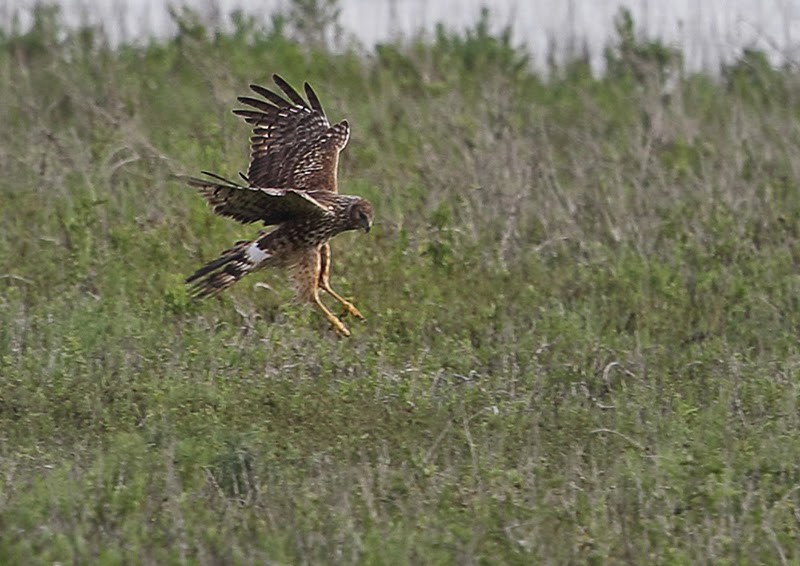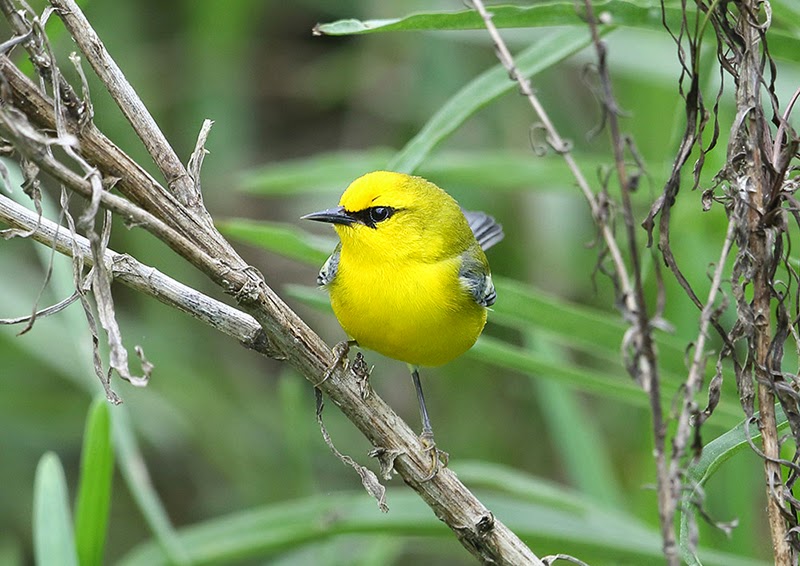After travelling to our first motel in Conroe we spent some time looking for birds on the way to the next centre, Rockport. First we stopped off in the W.G. Jones State Forest and spent the morning there enjoying good views of Eastern Bluebird, Red-bellied and Downy woodpeckers, as well as several raptors, including Swainson's, Red-shouldered and Red-tailed Hawks. The most numerous bird was undoubtedly the various grackles - Common, Great-tailed and Boat-tailed. Almost all of these were lifers. In birdspeak, a "lifer" is a bird you see for the first time in your life.
 |
| Eastern Bluebird. There was a car named after it! |
 |
| Downy Woodpecker |
 |
| Red-bellied Woodpecker |
 |
| Whooping Crane, or whopping crane - it's about 2m tall. |
For me, even better were the Black skimmers, as well as an array of terns and waders.
The skipper also took us close to shore to see the endangered Seaside sparrow, American avocets, as well as a Great Horned owl in the daytime which seemed to be drying our after the rain of the previous night. Even our humble Herring Gull was there.
 |
| Black Skimmers. Hard to see here but the lower mandible is much longer than the upper. It skims the water with the lower mandible in the water, snapping it shut when it contacts a fish. |
 |
| American Avocets |
 |
| American Oystercatchers (with chick - look carefully!) |
 |
| Herring Gull - anyone know what fish it's caught? |
 |
| Northern Harrier |
 |
| Seaside Sparrow |
 |
| Roseate Spoonbills |
 |
| Caspian Tern - with that huge carrot bill. |
 |
| Least Tern - the smallest. |
 |
| Royal Tern - nearly as big as Caspian |
 |
| Reddish Egrets - male displaying |
 |
| Great Egret displaying, followed inevitably by . . . |
 |
| . . . mating! |
 |
| Great Egrets mating |
There was a small local wildlife park which produced Black-chinned hummingbird, Mottled duck, Green heron, Black-bellied whistling ducks, Northern cardinal, Blue-winged teal, Cedar waxwing and Golden-fronted woodpecker.
 |
| Black-chinned Hummingbird |
 |
| Northern Cardinal - female |
 |
| Cedar Waxwings |
 |
| Golden-fronted Woodpecker. It had a strange display where it spread its wings either side of the branch. |
 |
| Green Heron |
 |
| Black-bellied Whistling-duck - as common as our Mallard. |
 |
| Summer Tanager. Very colourful like the Northern Cardinal, but without the crest. |
On day we had a long drive to Brownsville. This found us just on the US side of the Mexico-US border. We spent the next five nights here. On the way, Scissor-tailed Flycatchers were quite common on wires and near petrol stations. These were nesting in the floodlight of a petrol station.
 |
| Scissor-tailed Flycatchers. Male with longer tail - naturally. |
 |
| Scissor-tailed Flycatcher |
 |
| Red-winged Blackbird. Not really a blackbird at all. |
 |
| Chihuahuan Raven. Quite handsome if you appreciate corvids. |
 |
| Harris's Hawk. Often a captive hunting bird. |
 |
| Northern Mockingbird. Very common. |
We visited various reserves and forests, notably the Conference Centre and the adjacent Bird Observatory on South Padre Island just off the main coast of Texas. It is this island that many migrating birds hit first on crossing the Gulf of Mexico. They are tired and hungry. As a consequence they are more confiding than normal and one can get quite close to them.
Unfortunately, the weather wasn't as bad as we had hoped (?) so there were not quite as many migrants as there could have been. There was no 'fall' of birds because of bad weather. Nevertheless, we did see quite a few and some were spectacular. We even saw an unexpected Magnificent frigatebird flying over.
 |
| Magnificent Frigatebird |
Franklin Gulls were also migrating and there were a couple of large flocks, c1000 each, which landed on the beach.
 |
| Franklin's Gulls - part of a flock of around 1000 |
 |
| Franklin's Gull - Look at that lovely pink breeding flush. |
I watched the trees around the centre and tried to get shots of the warblers and orioles.
 |
| Baltimore Oriole |
 |
| Hooded Oriole |
 |
| Orchard Oriole |
 |
| Northern Parula |
 |
| Blue-winged Warbler. Sorry you can't see the wings from this angle. |
 |
| Prothonotary Warbler. This is one for me. It's name means 'the first notary'! |
 |
| Worm-eating Warbler. This one was quite weak and looked as if he might not make it. I hope he did. |
We also did a boardwalk to find Sora and Clapper Rail but they were very elusive here, yielding only brief glimpses of the Sora. On another day we looked round the adjoining bird observatory. Here we had more luck. We saw several Sora and Clapper rails, as well as several other waders, etc.
 |
| Sora. Normally skulking, this one was quite confiding. |
 |
| Clapper Rail. This one was fairly skulking. Boy, was it noisy! Had a video of it but I re-formatted the card before downloading it. Oops! |
 |
| Great Blue Heron - one of the biggest. |
 |
| Kildeer. Larger than ringed plover and with two breast bands |
 |
| Stilt Sandpiper |
 |
| Black-necked Stilt. The longest legs, relative to body size, of any bird! |
 |
| Greater Yellowlegs |
 |
| Lesser Yellowlegs |
A trip West to Santa Ana National Wildlife Refuge was a nice diversion. The Chachalakas made a wonderful raucous duet above our heads. The Green Jay was confiding and we enjoyed good views of a Greater Roadrunner and Eastern Wood peewee. Also distant views of Wilson's snipe.
 |
| Chachalaka - Wonderfully vocal and loud. They would probably get on your nerves if you lived nearby! |
 |
| Green Jay |
 |
| Greater Roadrunner. That's not his own chick he's carrying. |
 |
| Common Gallinule |
Our visit to Sabal Palm Sanctuary was interesting and brought us Buff-Bellied Hummingbird for the first time and good views of the Great Horned Owl and chicks. Also Least Grebe and Least Bittern. We also saw several doves. My wife calls them all pigeons but I have a soft spot for Colombinas, etc.
 |
| Buff-bellied Hummingbird. |
 |
| Great-horned Owl |
 |
| Great-horned Owl chick. Well, chicks - see his brother peeking out from behind. Aaah! |
 |
| Inca Dove. Small, but perfectly formed. |
 |
| Mourning Dove. Had by no means the most mournful call. That honour goes to the White-tipped Dove. |
 |
| White-tipped Dove. With a call to slit your wrists to! |
 |
| White-winged Dove. With a beautiful blue eye ring. |
 |
| Least Bittern |
 |
| Least Grebe |
 |
| Long-billed Thrasher - a sort of Thrush-zilla |
 |
| Carolina Wren. Quite a big wren. |
In the afternoon we headed back to South Padre Island where we saw some new sparrows, vireos, cuckoo and thrushes.
 |
| Yellow-billed Cuckoo - with yellow-tipped caterpillar! |
 |
| Dickcissel - where do they think of these names! |
 |
| Lark Sparrow |
 |
| Lincoln's Sparrow |
 |
| Savannah Sparrow |
 |
| Veery. A small thrush. |
 |
| Warbling Vireo |
 |
| Black-and-white Warbler. Cute and very mobile. |
 |
| House Wren. Quite like our wren really. |
 |
| Painted Bunting. We got only one good view of this very handsome bird. |
 |
| Yellow-crowned Night-heron. I know you can't see the yellow crown here. I should have ended with the Painted Bunting! |
The day of our departure saw us make a brief stop at Jesse Jones (not James) State Park. Carolina chickadee and House finch were the highlights.
The plane journey back wasn't too bad. I didn't sleep but I managed to get rid of the engine noise with my noise cancelling headphones. I can thoroughly recommend them for long trips. I've a feeling they will come in very useful on future trips.
Absolutely fabulous photos, Phil. The Green Jay and the Painted Bunting are two of my favorites. Glad you had such a lovely time.
ReplyDelete